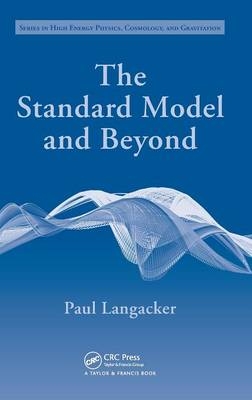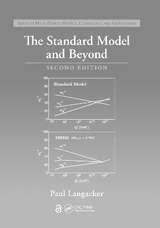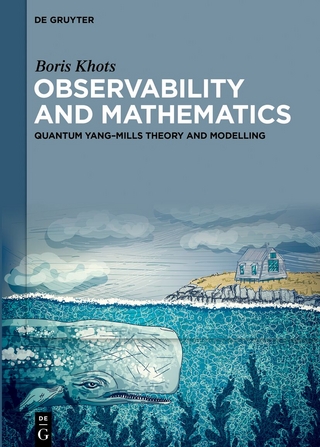
The Standard Model and Beyond
Taylor & Francis Inc (Verlag)
978-1-4200-7906-7 (ISBN)
- Titel erscheint in neuer Auflage
- Artikel merken
The Standard Model and Beyond presents an advanced introduction to the physics and formalism of the standard model and other non-abelian gauge theories. It provides a solid background for understanding supersymmetry, string theory, extra dimensions, dynamical symmetry breaking, and cosmology.
The book first reviews calculational techniques in field theory and the status of quantum electrodynamics. It then focuses on global and local symmetries and the construction of non-abelian gauge theories, before explaining the structure and tests of quantum chromodynamics. The book also describes the electroweak interactions and theory, including neutrino masses. The final chapter discusses the motivations for extending the standard model and examines supersymmetry, extended gauge groups, and grand unification.
Thoroughly covering gauge field theories, symmetries, and topics beyond the standard model, this text equips readers with the tools to understand the structure and phenomenological consequences of the standard model, to construct extensions, and to perform calculations at tree level. It establishes the necessary background for readers to carry out more advanced research in particle physics.
Supplementary materials are provided on the author’s website and a solutions manual is available for qualifying instructors.
Paul Langacker is a Member of the Institute for Advanced Study in Princeton, New Jersey. Dr. Langacker is also Emeritus Professor of Physics and Astronomy at the University of Pennsylvania.
Notation and Conventions
Review of Perturbative Field Theory
Creation and Annihilation Operators
Lagrangian Field Theory
The Hermitian Scalar Field
The Complex Scalar Field
Electromagnetic and Vector Fields
Electromagnetic Interaction of Charged Pions
The Dirac Field
Quantum Electrodynamics (QED) for Electrons and Positrons
Spin Effects and Spinor Calculations
The Discrete Symmetries P, C, CP, T, and CPT
Two-Component Notation and Independent Fields
QED
Mass and Kinetic Mixing
Lie Groups, Lie Algebras, and Symmetries
Basic Concepts
Global Symmetries in Field Theory
Symmetry Breaking and Realization
Gauge Theories
The Abelian Case
Non-Abelian Gauge Theories
The Higgs Mechanism
The Rξ Gauges
Anomalies
The Strong Interactions and Quantum Chromodynamics (QCD)
The QCD Lagrangian
Evidence for QCD
Simple QCD Processes
The Running Coupling in Non-Abelian Theories
Deep Inelastic Scattering
Other Short Distance Processes
The Strong Interactions at Long Distances
The Symmetries of QCD
Other Topics
The Weak Interactions
Origins of the Weak Interactions
The Fermi Theory of Charged Current Weak Interactions
The Standard Electroweak Theory
The Standard Model Lagrangian
Spontaneous Symmetry Breaking
The Z, the W, and the Weak Neutral Current
Gauge Self-Interactions
The Higgs
The CKM Matrix and CP Violation
Neutrino Mass and Mixing
Beyond the Standard Model
Problems with the Standard Model
Supersymmetry
Extended Gauge Groups
Grand Unified Theories (GUTs)
Appendix A: Canonical Commutation Rules
Appendix B: Derivation of a Simple Feynman Diagram
Appendix C: Unitarity, the Partial Wave Expansion, and the Optical Theorem
Appendix D: Two, Three, and n-Body Phase Space
Appendix E: Calculation of the Anomalous Magnetic Moment of the Electron
Appendix F: Breit–Wigner Resonances
Appendix G: Implications of P, C, T, and G-parity for Nucleon Matrix Elements
Appendix H: Collider Kinematics
Appendix I: Quantum Mechanical Analogs of Symmetry Breaking
References
Websites
Index
Problems appear at the end of each chapter.
| Erscheint lt. Verlag | 7.12.2009 |
|---|---|
| Reihe/Serie | Series in High Energy Physics, Cosmology and Gravitation |
| Zusatzinfo | 24 Tables, black and white; 129 Illustrations, black and white |
| Verlagsort | Washington |
| Sprache | englisch |
| Maße | 156 x 234 mm |
| Gewicht | 1072 g |
| Themenwelt | Naturwissenschaften ► Physik / Astronomie ► Hochenergiephysik / Teilchenphysik |
| ISBN-10 | 1-4200-7906-9 / 1420079069 |
| ISBN-13 | 978-1-4200-7906-7 / 9781420079067 |
| Zustand | Neuware |
| Haben Sie eine Frage zum Produkt? |
aus dem Bereich



